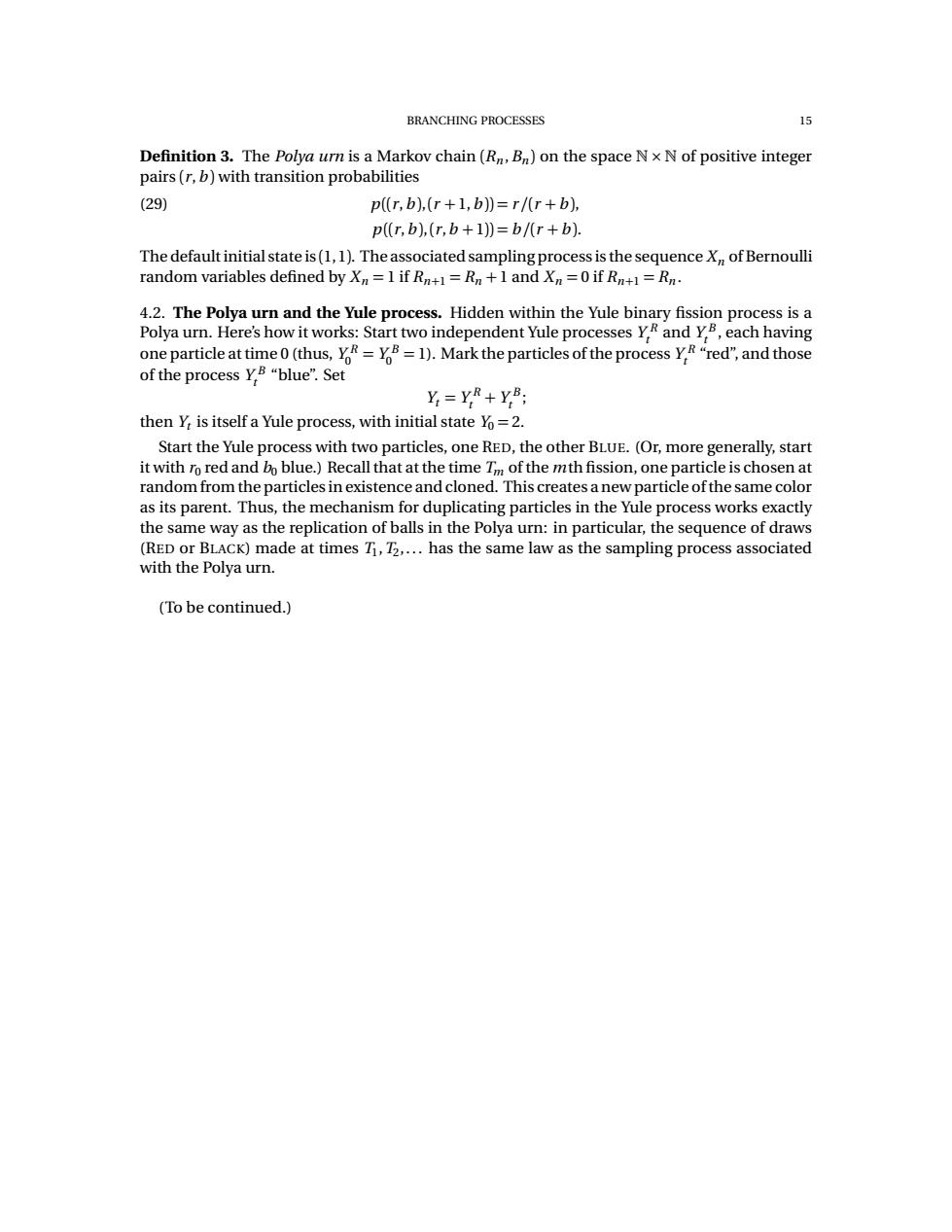正在加载图片...

BRANCHING PROCESSES 15 Definition 3.The Polya urn is a Markov chain(Rn,B)on the space Nx N of positive integer pairs(r,b)with transition probabilities (29) p(r,b),(r+1,b)=r/r+b, p(r,b),(r,b+1)=b/r+b). The default initial state is(1,1).The associated sampling process is the sequence X of Bernoulli random variables defined by Xn=1 if Rn+1=Rn+1 and Xn=0 if Rn+1=Rn. 4.2.The Polya urn and the Yule process.Hidden within the Yule binary fission process is a Polya urn.Here's how it works:Start two independent Yule processes YR and yB,each having one particle at time(thus,==1).Mark the particles ofthe process yR"red",and those of the process Y.B“blue”.Set Y=YR+YB; then Y is itself a Yule process,with initial state Yo=2. Start the Yule process with two particles,one RED,the other BLUE.(Or,more generally,start it with ro red and bo blue.)Recall that at the time Tm of the mth fission,one particle is chosen at random from the particles in existence and cloned.This creates a new particle ofthe same color as its parent.Thus,the mechanism for duplicating particles in the Yule process works exactly the same way as the replication of balls in the Polya urn:in particular,the sequence of draws (RED or BLACK)made at times Ti,T2,...has the same law as the sampling process associated with the Polya urn. (To be continued.)BRANCHING PROCESSES 15 Definition 3. The Polya urn is a Markov chain (Rn ,Bn ) on the space N × N of positive integer pairs (r,b ) with transition probabilities p((r,b ),(r + 1,b )) = r /(r + b ),(29) p((r,b ),(r,b + 1)) = b /(r + b ). The default initial state is (1, 1). The associated sampling process is the sequence Xn of Bernoulli random variables defined by Xn = 1 if Rn+1 = Rn + 1 and Xn = 0 if Rn+1 = Rn . 4.2. The Polya urn and the Yule process. Hidden within the Yule binary fission process is a Polya urn. Here’s how it works: Start two independent Yule processes Y R t and Y B t , each having one particle at time 0 (thus, Y R 0 = Y B 0 = 1). Mark the particles of the process Y R t “red”, and those of the process Y B t “blue”. Set Yt = Y R t + Y B t ; then Yt is itself a Yule process, with initial state Y0 = 2. Start the Yule process with two particles, one RED, the other BLUE. (Or, more generally, start it with r0 red and b0 blue.) Recall that at the time Tm of the mth fission, one particle is chosen at random from the particles in existence and cloned. This creates a new particle of the same color as its parent. Thus, the mechanism for duplicating particles in the Yule process works exactly the same way as the replication of balls in the Polya urn: in particular, the sequence of draws (RED or BLACK) made at times T1 ,T2 ,... has the same law as the sampling process associated with the Polya urn. (To be continued.)